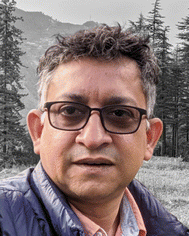Introduction to fundamental processes in optical nanomaterials
Alison M.
Funston
 *ab,
Eva
Hemmer
*ab,
Eva
Hemmer
 *c,
Arindam
Chowdhury
*c,
Arindam
Chowdhury
 *d and
Jonathan G. C.
Veinot
*d and
Jonathan G. C.
Veinot
 *e
*e
aARC Centre of Excellence in Exciton Science, Monash University, Clayton, Victoria 3800, Australia. E-mail: alison.funston@monash.edu
bSchool of Chemistry, Monash University, Clayton, Victoria 3800, Australia
cDepartment of Chemistry and Biomolecular Sciences, University of Ottawa, Ottawa, ON, Canada. E-mail: ehemmer@uottawa.ca
dDepartment of Chemistry, Indian Institute of Technology Bombay, Powai, Mumbai 400076, India. E-mail: arindam@chem.iitb.ac.in
eDepartment of Chemistry, University of Alberta, Edmonton, Alberta T6G 2G2, Canada. E-mail: jveinot@ualberta.ca
Abstract
An introduction to the joint Nanoscale and Chemical Communications (ChemComm) themed collection focused on fundamental processes in optical nanomaterials that features a series of articles describing the properties of this versatile class of materials while highlighting some of their potential applications.
The importance of the unique material- and size-dependent optical response of nanomaterials is exemplified by the “story” of semiconductor nanoparticles (or quantum dots) that were first prepared by Moungi Bawendi, Louis Brus and Aleksey Yekimov. They were awarded the 2023 Nobel Prize in Chemistry for their discovery.† Synthesis methods that provide quantum dots of well-defined size, shape, composition, and surface chemistry have enabled understanding, control, and ultimately exploitation of the influences of quantum confinement in these materials and facilitated the realization of practical applications. This themed collection provides a glimpse into the design and preparation of a variety of other nanomaterials, fundamental processes that lead to their optical properties, factors that affect these properties, and how they can be probed; many contributions also discuss prototype applications.
Nanomaterial optical properties and their corresponding applications are as diverse as the materials themselves, ranging from optical imaging probes to thermal sensors and photocatalysis. This diversity is well illustrated by contributions related to lanthanide-based emitters. For instance, Calado et al. report the interplay of TbIII and EuIII ions within dual-emitting molecular cluster-aggregates (https://doi.org/10.1039/D3CC03658H). In their work, precise control over the decay of the TbIII and EuIII excited states resulted in materials that exhibit thermal sensing capabilities. Another example for lanthanide-based optical thermometry is described by Ramos et al., who assessed the application potential of YbIII and ErIII co-doped Gd2O3 for thermal sensing (https://doi.org/10.1039/D3NR01764H). In this study, the authors investigated white light upconversion emission arising from YbIII/ErIII in co-doped nanopowders and mechanical mixtures. The versatility of lanthanide-based nanomaterials has also been demonstrated by Kaur et al., namely the photocatalytic capability of dye-sensitized upconverting nanoparticles (https://doi.org/10.1039/D3NR02845C). The importance of controlling their composition and structure are further exemplified by Cuau et al. (https://doi.org/10.1039/D3NR03710J) and Liu et al. (https://doi.org/10.1039/D3NR05380F) who demonstrate the synthesis of TbIII-doped and core/multi-shell nanocrystals, respectively, and show their prototype utility as multimodal imaging probes.
The community's understanding of silicon nanosheets (silicane) and the tunability of their optical properties is expanded upon in a report by Stavrou et al. (https://doi.org/10.1039/D3NR03497F). In their contribution the authors describe the synthesis and functionalization of silicane bearing styrene or tert-butyl methacrylate moieties. Investigation of the nonlinear optical response (NLO) of these functionalized silicanes revealed enhancements, in both cases, when compared to that of the pristine Si–H terminated systems while providing superior NLO absorption and refraction. New insights into fundamental aspects of silicon nanoparticles (https://doi.org/10.1039/D3NR04478E) and the control of superchiral resonances of silicon metasurfaces (https://doi.org/10.1039/D3NR05285K) open routes to novel nanomaterials for optoelectronics, imaging, and sensing applications.
Rounding out this special collection, progress related to metal-quantum dot nanohybrids and their application in fluorescence biosensing is provided by Hildebrandt et al. (https://doi.org/10.1039/D2CC06178C). In their contribution the authors provide a comprehensive summary of the status of the field while describing the fundamental processes related to plasmonic enhancement and quenching of quantum dot luminescence, prototype applications and future potential for these systems. Seeking novel applications of plasmonic nanostructures, a study by Kashyap et al. reveals the prospects of plasmonic nano-catalysts in conducting energy intensive chemical synthesis in a sustainable fashion. Herein, the sole effect of plasmonic-heat in driving a high temperature organic transformation is demonstrated (https://doi.org/10.1039/D3CC04278B). Catalysis processes at plasmonic nanoparticle surfaces are complicated by ligand effects. Joshi et al. show that by harnessing the electron transfer properties of these ligands, their catalytic properties can be improved (https://doi.org/10.1039/D3NR02829A). Effects of thermal annealing on the optical properties of plasmonic materials and new synthetic pathways to plasmonic ZrN nanoparticles are presented by Chen et al. (https://doi.org/10.1039/D3NR03522K) and Protsak et al. (https://doi.org/10.1039/D3NR03999D).
In addition to molecular, inorganic, and metallic nanomaterials, polymers with optical properties are also showcased in this collection. For example, Suharman et al. fabricated thermally tolerant polymer optical resonators from a stereocomplex of poly(L-lactic acid) and poly(D-lactic acid) through the oil-in-water miniemulsion method. The resultant optical resonators preserved their properties up to an elevated temperature of 230 °C (https://doi.org/10.1039/D3NR05318K).
This themed collection of contributions related to the optical properties of nanomaterials provides a snapshot of the vast potential of intriguing systems. With the ever-advancing synthesis methods that provide exquisite control over material architectures combined with technological advances in material characterization that facilitate increased understanding of the processes, it is reasonable to expect new materials and applications to emerge.
Footnote |
| † https://www.nobelprize.org/prizes/chemistry/2023/press-release/ |
| This journal is © The Royal Society of Chemistry 2024 |




